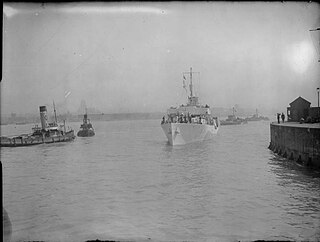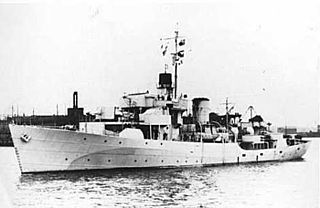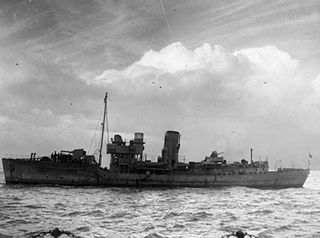
The Flower-class corvette was a British class of 294 corvettes used during World War II by the Allied navies particularly as anti-submarine convoy escorts in the Battle of the Atlantic. Royal Navy ships of this class were named after flowers.

HMS Arbutus was a Flower-class corvette of the Royal Navy, which was active during the Second World War. She was a successful escort vessel, and took part in the destruction of two U-boats during the Battle of the Atlantic. Arbutus was sunk in the North Atlantic in February 1942.
HMS Heartsease was a Flower-class corvette of the Royal Navy. She served with both the Royal Navy and the United States Navy during the Second World War, with the latter navy as USS Courage. She then spent several years under a succession of names in civilian service. In 1957 she was chartered on behalf of Indonesian rebels to smuggle rubber, copra and matériel. The Indonesian Air Force intercepted and sank her off the coast of Minahasa in North Sulawesi in December 1958.

HMS Peony was a Flower-class corvette of the Royal Navy. In 1943 she was transferred to the Royal Hellenic Navy as RHNS Sachtouris, serving throughout World War II and the Greek Civil War. She was returned to the Royal Navy in 1951 and scrapped in April 1952.

USS Surprise (PG-63), the fourth American naval ship of the name, was a Temptress-class patrol gunboat during World War II. She was built as the British Flower-class corvette HMS Heliotrope, and was in service with the Royal Navy during the first years of the Battle of the Atlantic. She was loaned to and operated by the United States Navy from 1942–1945. After World War II, she was sold as a merchant vessel and ended her life in the Chinese navy as Lin I.

HMS Begonia was a Flower-class corvette that served in the Royal Navy during World War II. In 1942 she was lent to the United States Navy and commissioned as USS Impulse. Returned to the Royal Navy in 1945, Begonia was stricken and sold into merchant service. She was wrecked off the coast of Spain in 1970.

HMS Bellwort was a Flower-class corvette built for the Royal Navy during World War II.
HMS Arabis was a Flower-class corvette of the Royal Navy. The ship was commissioned into the Royal Navy as HMS Arabis. She was transferred to the United States Navy in 1942, serving as USS Saucy. Returned to the United Kingdom in 1945, she was recommissioned into the Royal Navy as HMS Snapdragon.
When the United States entered World War II at the end of 1941, the United States Navy found itself deficient in ocean escort-type vessels. A crash building program was instituted; but, to meet more immediate needs, the government contracted with shipbuilding firms in England and Canada to build Flower-class corvettes. Vim (PG-99) was one of those British-type escorts. She was launched on 1 April 1943 at the Collingwood Shipyard in Collingwood, Ontario. Nine days later, however, she was transferred to the Royal Navy under the terms of the lend-lease agreement in return for another Flower-class corvette then under construction in Canada. The British renamed her HMS Statice, and she served the Royal Navy under the name through World War II. On 21 June 1946, she was returned to the United States Navy. Though carried on the Navy list as PG-99, the corvette never saw active service with the United States Navy. She was sold on 7 May 1947. To whom she was sold and to what purpose she was put is unknown.
HMS Veronica was a Flower-class corvette, built for the Royal Navy during the Second World War, and was in service in the Battle of the Atlantic. In 1942 she was transferred to the United States Navy as part of the reverse Lend Lease arrangement and renamed USS Temptress, the name ship of the Temptress-class gunboats. With the end of hostilities she was returned to the Royal Navy and sold into mercantile service.
HMS Candytuft was a Flower-class corvette, built for the Royal Navy during the Second World War, and was in service in the Battle of the Atlantic. In 1942 she was transferred to the United States Navy as part of the reverse Lend Lease arrangement and renamed USS Tenacity, one of the Temptress-class gunboats. With the end of hostilities she was returned to the Royal Navy and sold into merchantile service.

HMCS Forest Hill was a modified Flower-class corvette that served with the Royal Canadian Navy during the Second World War. She served primarily as a convoy escort in the Battle of the Atlantic. She was originally laid down by the Royal Navy as HMS Ceanothos but was never commissioned into the RN, being transferred to the RCN before completion. She is named for Forest Hill, Ontario, a town that was eventually amalgamated into the larger city Toronto, Ontario.

HMCS Mimico was a modified Flower-class corvette that served with the Royal Canadian Navy during the Second World War. She served primarily as a convoy escort in the Battle of the Atlantic. She was originally laid down by the Royal Navy as HMS Bullrush but was never commissioned into the RN, being transferred to the RCN before completion. She is named for Mimico, Ontario, a town that was eventually amalgamated into the larger city Toronto, Ontario.

HMS Rochester (L50) was a Shoreham-class sloop of the Royal Navy. She served during the Second World War and was a successful anti-submarine warfare vessel, being credited with the destruction of five U-boats.

HMS Rhododendron was a Flower-class corvette that served with the Royal Navy during the Second World War. She served as an ocean escort in the Battle of the Atlantic.
HMS Coreopsis was a Flower-class corvette, built for the Royal Navy during the Second World War which served in the Battle of the Atlantic. In 1943, she was transferred to the Royal Hellenic Navy as RHNS Kriezis and participated in the 1944 Invasion of Normandy. Shortly before she was scrapped, she took part in the British war film, The Cruel Sea.

HMS Alisma was a Flower-class corvette that served in the Royal Navy.

HMS Hibiscus was a Flower-class corvette, built for the Royal Navy during the Second World War, and was in service in the Battle of the Atlantic. In 1942 she was transferred to the United States Navy as part of the Reverse Lend-Lease arrangement and renamed USS Spry, one of the Temptress-class gunboats. With the end of hostilities she was returned to the Royal Navy and sold into mercantile service.

HMS Periwinkle was a Flower-class corvette, built for the Royal Navy during the Second World War, and was in service in the Battle of the Atlantic. In 1942 she was transferred to the United States Navy as part of the Reverse Lend-Lease arrangement and renamed USS Restless, one of the Temptress-class gunboats. With the end of hostilities she was returned to the Royal Navy and sold into mercantile service.

HMS Larkspur was a Flower-class corvette, built for the Royal Navy during the Second World War, and was in service in the Battle of the Atlantic. In 1942 she was transferred to the United States Navy as part of the Reverse Lend-Lease arrangement and renamed USS Fury, one of the Temptress-class gunboats. With the end of hostilities she was returned to the Royal Navy and sold into mercantile service.













